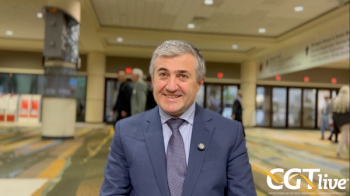
Goy Discusses Maintenance, CAR T-Cell Therapy in MCL
Andre Goy, MD, shares insight on the new array of treatment options for mantle cell lymphoma and how to properly implement them.
Andre Goy, MD
Promising clinical trial data have highlighted advances in the treatment of mantle cell lymphoma (MCL), but an important next step is applying this progress to routine clinical practice, said Andre Goy, MD.
These recent data have not only suggested that patients with MCL can expect a better quality of life with novel therapies, but also that maintenance regimens and chimeric antigen receptor (CAR) T-cell therapy could be a pivotal part of the future landscape.
For example, rituximab (Rituxan) has demonstrated activity in the maintenance setting. A meta-analysis presented at the 2018 ASCO Annual Meeting indicated that rituximab maintenance following induction chemoimmunotherapy significantly improved overall survival (OS) and progression-free survival (PFS) for patients with MCL.1
Venetoclax (Venclexta) as a single agent has also resulted in deep and durable responses, recent data suggest. In a study presented at the 2018 European Hematology Association Congress, venetoclax induced an overall response rate of 60% in patients with relapsed/refractory MCL who were previously treated with a BTK inhibitor.2 The complete response (CR) was 20%.
Furthermore, the Nordic MCL2 and MCL3 trials, Goy explained, addressed the issue of what physicians can do in terms of identifying patients who require interventions aimed to prolong clinical remission. Minimal residual disease (MRD) monitoring could be the key there.
OncLive: Please provide an overview of your presentation on MCL.
In an interview with OncLive at the 2018 Pan Pacific Lymphoma Conference, Goy, chief of the Division of Lymphoma, and chairman and director of John Theurer Cancer Center, shared insight on the new array of treatment options for MCL and how to properly implement them.Goy: I am here to share my perspective on MCL and some of the progress we have made. Importantly, we have made significant progress. However, there is a disconnect with what we've seen in clinical trials and in the real world. Overall, in clinical trials, there's been a great endeavor of pushing research in MCL because the outcome with standard therapy is very dismal. If we look at the progression of the last 3 decades in clinical trials of MCL, the median OS went from 2.5 years, or something like that, to 12 or 13 years. Therefore, there has definitely been progress on that front.
We also have some potential for patients to be cured, especially those who are MRD negative in the context of younger patients. Rituximab has had tremendous impact in terms of PFS and OS. Where the field is going is trying to optimize treatment by looking at different phases and trying to improve outcomes that way. This is important because although we've seen great progress in these trials, there's a disconnect. Median OS in the real world is still about 3 to 5 years.
One thing that's been identified is that for patients in their mid-to-late 60s, we can use maintenance therapy, particularly rituximab. Maintenance is now standard of care. The question that remains is what to do beyond that. In a relapsed setting, there are a number of different therapies—5 are approved.
The questions that remain are, “How long do you give maintenance therapy? Can you build up on the maintenance with rituximab? How often you need to monitor these patients? Can we do something preemptively to prevent the patient from clinically progressing?” That's what the Nordic trial showed. The median time to molecular CR was about 55 months. About 90% of patients went back on rituximab. We need to do more than just rituximab as a maintenance therapy.
Does CAR T-cell therapy have potential in the treatment of patients with MCL?
Overall, we have a very changing landscape in MCL. The last aspect that is important to note is that clinical trials don't necessarily represent reality. However, we can still take the information we get and understand the disease better. I'm optimistic for what is on the horizon.There has been a lot of talk about CAR T cells and there's a lot of excitement. There have been some approvals in other lymphomas; commercial use is now available. We are now following the activity of these agents in patients with MCL. There are a handful of patients we are looking at this on a phase II trial. We are looking at some of the early data right now with ibrutinib.
There have been some exciting data with venetoclax. What are your thoughts?
Is there anything else in the early stages that you are particularly excited about?
What is the takeaway message you would like community oncologists to leave with?
We are seeing some high responses and exciting data, but it's too early to get into right now. This is something that will be appealing, though. One of the biggest challenges in MCL is that it is chemotherapy resistant over time. Some patients cannot be pulled back into remission with standard therapy.Venetoclax has shown dramatic activity in early studies as a single agent in MCL. It's been very impressive, even in patients who did not respond to ibrutinib (Imbruvica). What is interesting is the combination setting. This will translate into better results in the fourth-line setting for these patients, and it's purely a nonchemotherapy option.As I alluded to before, ibrutinib is a form of immunotherapy that is used in combination with a targeted therapy in MCL. There was a trial presented recently that showed patients who were heavily pretreated had a CR rate of 71%. There was another study of exactly the same design that showed a very high response rate, even in those with poor genetic risk factors. This is a good example of what immunotherapy can do. There is a lot of opportunity with anti-CD47 and other forms of immunotherapy that might provide opportunity.We have made a lot of progress, thanks to clinical trials. I want more people to participate in trials. This is a really bright time in the future of MCL; this is a big step towards a cure.
References
- Hilal T, Wang Z, Almader-Douglas D, et al. Rituximab maintenance for mantle cell lymphoma: a meta-analysis. J Clin Oncol. 2018;36 (suppl; abstr e19557).
- Eyre T, Walter H, Iyenger S, et al. Efficacy of venetoclax monotherapy in patients with relapsed, refractory mantle cell lymphoma post BTK inhibition therapy. In: Proceedings from the 2018 EHA Congress; June 14-17, 2018; Stockholm, Sweden. Abstract S855.
Newsletter
Stay at the forefront of cutting-edge science with CGT—your direct line to expert insights, breakthrough data, and real-time coverage of the latest advancements in cell and gene therapy.

















































